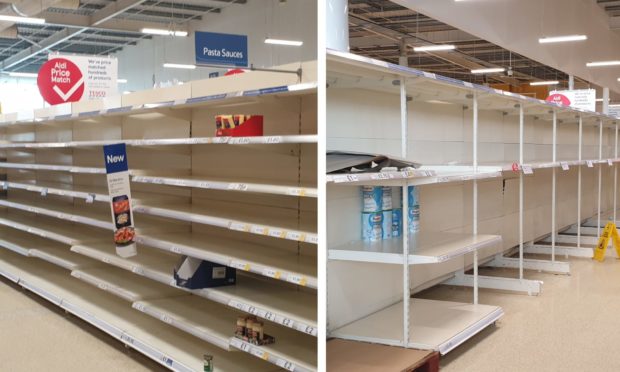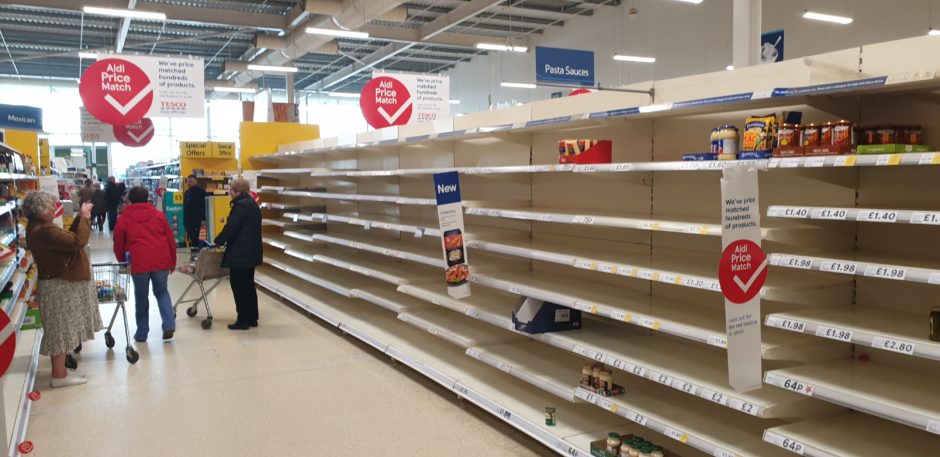Retail consultant James Logie explains why shoppers take fright – and the chaos it causes for both retailers and their suppliers.
The panic buyer is back with a vengeance.
Once again the depressing – and alarming – sight of empty aisles are appearing in supermarkets across the country despite there seemingly being no obvious reason for it.
Stores including Tesco and Morrisons have already introduced limits on how many items can be purchased at any one time in an effort to stop shoppers bulk-buying key products such as pasta and tinned tomatoes.
There is no shortage of toilet roll in the UK, yet some shelves lay bare. Mills are not running out of grain for flour, and hens have not stopped laying eggs. So why are consumers up to their old stockpiling tricks?
James Logie, MD of Retail Management Consultants in Stirling says we have fallen victim to herd mentality.
“It’s a mass psychosis. It’s one of these things that becomes self-fulfilling. We know it’s wrong but we all have a fear of losing out. People are hyper anxious in these strange times and I think social isolation heightens that inability to cope with uncertainty.
“People see empty shelves and then suddenly equate that with these items being more valuable than they actually are. They see a gap and think, ‘It must be worth something, I’d better have it’. It’s not driven by need at all, it’s a fear of losing out.
“When it comes to medicine shortages that’s a different kettle of fish, but when it’s loo roll I don’t think that use is going up, it’s just one of those irrational things, it’s like setting the heather on fire – once it starts it’s unstoppable. It’s a real herd mentality and the self-preservation gene kicks in.”
Though supermarkets appear to have been caught off-guard by the sudden rush for essentials, some had already brought in extra stocks of flour having predicted an upturn in baking due to the return of The Great British Bake Off to our television screens.
But fears over the prospect of even tougher lockdown restrictions seem to have spooked consumers into snapping up other items, leading to the return of the empty shelves.
As James Logie explains, supermarkets stocks are tightly controlled and designed to factor in seasonal and other variables – but, until now, not pandemics.
He said: “Most depos only typically carry one week’s stock, not just the perishable stuff but the large bulky stuff too, so they’re not sitting there with unlimited supplies waiting to go. Things are tightly controlled. Supermarkets plan to the nth degree. They analyse last year’s trading data by day, by hour, by season, so everything is on a just-in-time basis because supermarkets don’t want to have shelves full of bulky low-margin products like loo-roll taking up valuable space that could be given to a higher-margin brand.
“It’s a very careful calculation that’s made between both supplier and retailer. Disruption doesn’t take much to happen. They got caught out and didn’t see this coming. There’s going to be a gap that appears naturally with the whole rhythm of things.
“Having been through the last six months the supermarkets and suppliers are wise to this and I don’t think we’re going to see the sort of long-term systemic shortages we saw back in March/April time.”
How does panic buying affect suppliers and supermarkets?
“It causes massive disruption,” said James. “It hurts the entire supply chain and suppliers are forced to ramp up capacity to support sudden artificial demand. It upsets the normal trading rhythm of supermarkets which plan months ahead with forensic analysis. What they don’t want to do is to respond in a panic fashion themselves and become overstocked with stuff that they then can’t shift.
“The UK imports more than half of its fruit supply from international markets who have themselves been subject to export restrictions so things can’t magically be grown quicker. There are capacity restrictions and limits in the natural cycle of growing and selling. It can take months to repair these sudden surges.
“Supermarkets are having to face higher wage bills, they’ve had to bring in many more people to cope with the demand for cleaning and to make sure all these new online orders are being serviced so a lot of these stores that had 24-hour opening have gone back to 12-hour openings and have reverted to using nights to restock shelves but it’s all labour intensive and it costs wages.
“Even Amazon have hired 7,000 new people for the UK – and 100,000 in the US over the last month – to try to cope with the surge in online demand so the wage cost implication of the surge in demand through panic buying is immense.”
Reasons to be optimistic that things won’t be as bad this time around
But despite what we’re seeing in shops at the moment, James believes there is cause to expect things to settle down more quickly than last time.
He said: “Panic buying is an irrational action that deprives the most vulnerable so it’s also an irresponsible practice, but we’re all human beings and we all have to eat. The experience of the last six months has taught people that this will pass – it’s not pleasant and there is a nuisance value in queuing for longer, but people will look back and see the panic surge was meaningless in the end, and people were left sitting there with rooms full of toilet rolls that they still haven’t used six months on.
“I don’t think we’re going to be as susceptible six months on as we were first time around when no one knew what was ahead of us. Now we have hard evidence that this thing can be dealt with and processed so I don’t think people are as spooked as they were when it was all into the unknown for the government, retailers and the public at large. I don’t think it will be as severe this time.
“There may be local spikes and local panics and towards Christmas inevitably with the must-have toy or toilet rolls, there will be small spikes, but not the same irrational mass herd mentality of six months ago.”











